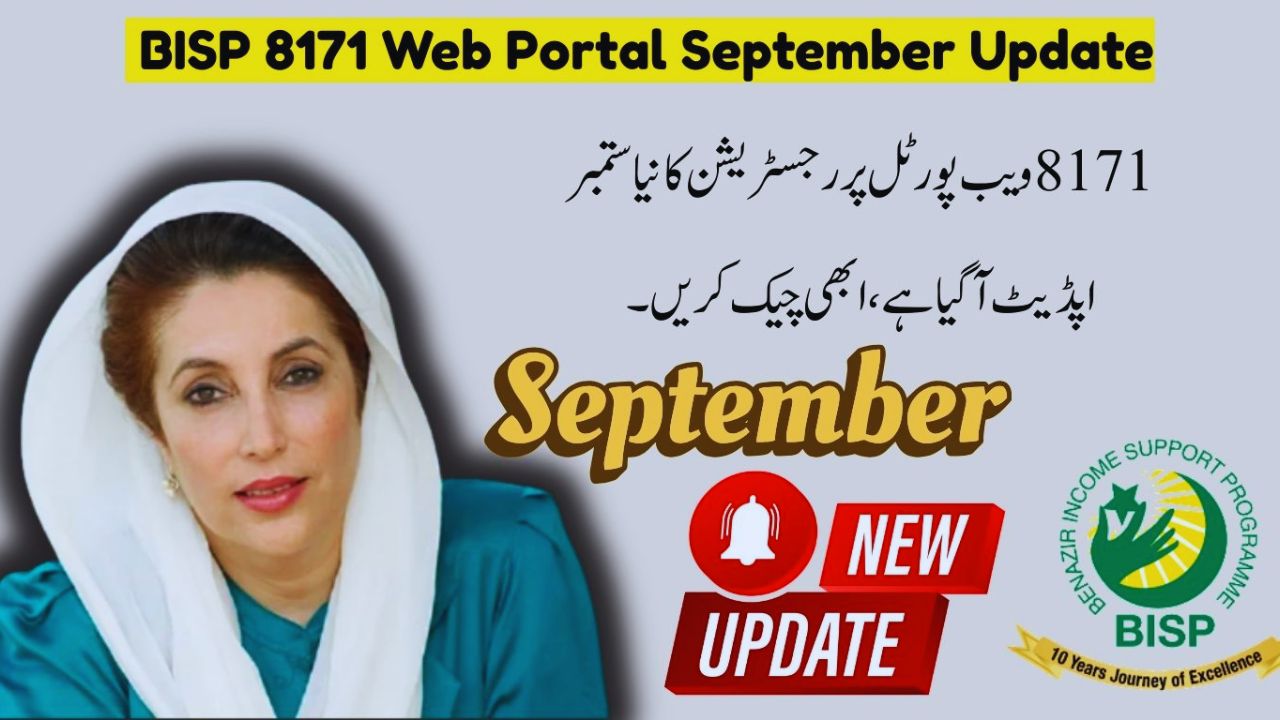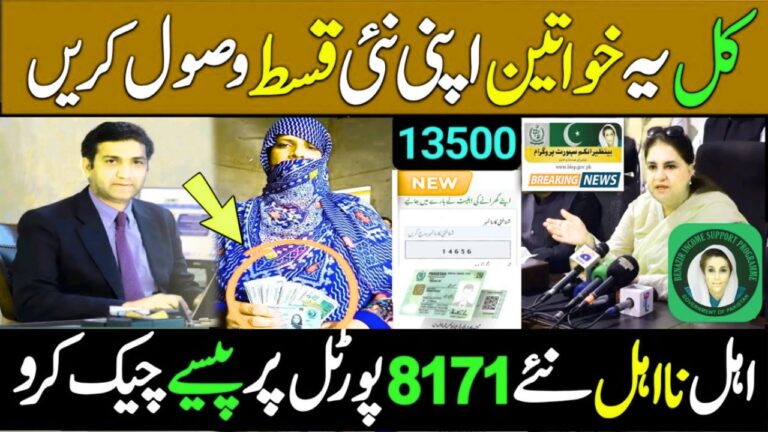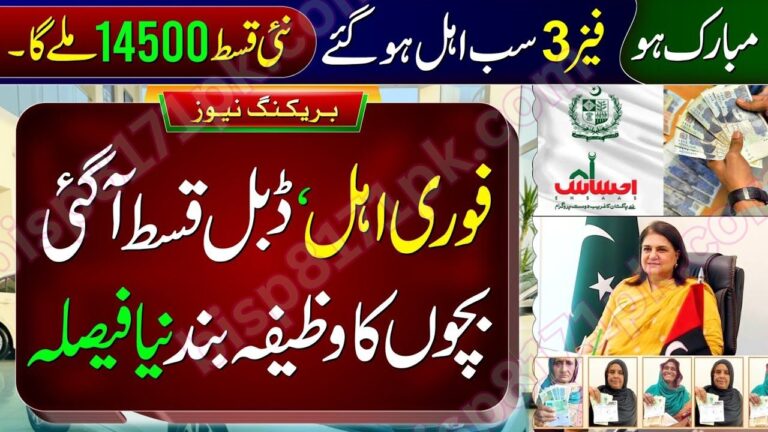BISP 8171 Web Portal Check Online CNIC Check – September 2025 Update
Table of Contents
ToggleIntroduction to BISP 8171 Program
The Benazir Income Support Programme (BISP) is one of Pakistan’s most significant welfare initiatives, designed to provide direct financial relief to families struggling with poverty. Introduced in 2008, the program has evolved with time, expanding its scope and improving its verification methods to ensure that the most deserving households benefit. The 8171 web portal is a digital gateway that makes it easier for citizens to check their eligibility and payment status online using their CNIC (Computerized National Identity Card) number.
The main purpose of this program is to uplift low-income families, reduce poverty, and create a safety net for women, widows, and vulnerable households. Over the years, the government has made the system more transparent and accessible by digitizing the process through online portals and SMS services. This allows beneficiaries to confirm whether they qualify for the program without needing to visit offices or stand in long queues.
With digitalization, BISP has also focused on making the process secure and free from corruption. The 8171 CNIC check system is an essential tool because it ensures that only genuine applicants receive financial support. It eliminates guesswork and provides instant verification, giving applicants peace of mind.
As of September 2025, the program has gone through important updates that further streamline the process. From eligibility requirements to new payment methods, everything is now aligned with modern technology and government reforms to ensure maximum reach and minimum fraud.
September 2025 Update: What’s New?
Every few months, the government reviews and updates the BISP 8171 program to address challenges and improve the experience for beneficiaries. The September 2025 update is especially important because it introduces new features and policy shifts.
First, the government announced an increase in financial aid to help families cope with inflation. Many beneficiaries will now receive slightly higher amounts, ensuring they can afford daily essentials like food, healthcare, and school expenses for children.
Second, the eligibility criteria have been updated. Families who own large properties or have a stable income above the poverty line will not qualify anymore. This ensures that the funds are only distributed to the most deserving households. However, widows, disabled individuals, and single mothers remain a top priority under the program.
Third, the BISP 8171 web portal has been upgraded with a more mobile-friendly interface. Since many users access the portal from smartphones, this change makes it easier for people in rural areas with limited resources to use the system effectively.
Another notable update is the integration with NADRA’s biometric system. This reduces the chances of duplicate registrations and fraud, making sure that funds go to the correct recipients.
Lastly, new digital payment options have been introduced. Apart from bank transfers and cash collection centers, mobile wallets are now being used for secure and quick transactions, giving beneficiaries more flexibility.
How to Use the BISP 8171 Web Portal
The BISP 8171 web portal is the primary online platform for applicants and beneficiaries to check their eligibility status, update information, and confirm payments. While the portal may look simple at first glance, many first-time users struggle with it. Here’s a detailed breakdown of how to use it effectively.
Step-by-Step Guide to Checking Eligibility Online
-
Visit the official BISP 8171 web portal (8171.bisp.gov.pk).
-
Enter your CNIC number in the designated field.
-
Complete the captcha verification to prove you’re not a bot.
-
Click on “Submit” and wait for the system to process your request.
-
The portal will display your eligibility status, along with any payment details.
This process usually takes less than a minute and provides clear results.
Mobile-Friendly Features for Easier Access
The redesigned portal now works seamlessly on smartphones. The September 2025 update introduced faster loading times, multilingual support (Urdu and English), and simplified navigation. This makes it especially useful for rural areas where internet speed is slow and people rely mostly on low-cost smartphones.
Common Issues Users Face and How to Solve Them
-
Invalid CNIC Error: Ensure that your CNIC is active and registered with NADRA.
-
Slow Loading: Use the portal during off-peak hours when fewer people are accessing it.
-
No Record Found: This may mean you’re not registered yet or your data has not been updated. In that case, visit the nearest BISP office.
-
Captcha Errors: Refresh the page and re-enter the captcha carefully.
By addressing these common problems, the government is working towards making the portal more user-friendly and reliable for everyone.
CNIC Verification Process in 2025
The CNIC verification process is at the heart of the BISP 8171 system. Without a valid CNIC, you cannot apply, check your eligibility, or receive payments. In 2025, the verification process has been further enhanced to ensure maximum security and transparency.
How to Check CNIC through the 8171 Portal
To check your CNIC, simply visit the 8171 portal, enter your number, and confirm your status. If you qualify, the system will display your eligibility and payment schedule.
SMS Service for Quick Verification
If you don’t have internet access, you can still check your status via SMS:
-
Open your messaging app.
-
Type your 13-digit CNIC number.
-
Send it to 8171.
-
You’ll receive a reply within seconds confirming whether you’re eligible.
This service is particularly helpful for people in villages and remote areas where internet services are unreliable.
Security Measures to Protect Beneficiaries
The 2025 update also includes stronger security protocols. NADRA’s biometric verification has been linked with the BISP system, preventing multiple registrations under a single identity. All transactions are now logged digitally, making the process more transparent.
This ensures that only deserving individuals receive financial aid, while fraudulent cases are flagged and investigated.
Eligibility Criteria for BISP 8171 in 2025
One of the most common questions people ask is, “Am I eligible for BISP 8171?” The answer lies in the eligibility criteria set by the government, which has been slightly revised in September 2025.
Who Can Apply?
-
Widows and single mothers
-
Families with no stable source of income
-
Households living below the poverty line
-
Disabled individuals unable to earn a livelihood
-
Senior citizens with no pension or support system
Income and Household Requirements
The program mainly targets families earning less than PKR 30,000 per month. Additionally, if your household does not own large property, a vehicle, or a business, you are more likely to qualify.
Exclusions from the Program
Certain groups are automatically excluded from receiving BISP benefits:
-
Government employees or pensioners
-
Business owners with registered firms
-
Families owning agricultural land above a certain size
-
Individuals who have traveled abroad frequently in the past years
The government uses NADRA and other databases to cross-check this information, ensuring that funds only reach the truly needy.
How to Apply for BISP 8171 Assistance
Applying for BISP 8171 assistance has become much easier in 2025 due to the introduction of digital systems and simplified processes. Citizens no longer need to go through lengthy paperwork or repeated visits to government offices. Instead, they can choose between online and offline registration methods depending on their accessibility and convenience.
Online Application Process
The online application process is the most convenient method, especially for people who have internet access. Here’s how you can apply:
-
Visit the official BISP 8171 web portal.
-
Click on the “Apply for Assistance” section.
-
Enter your CNIC number and basic family details (household size, monthly income, marital status).
-
Upload scanned copies of the required documents.
-
Submit the application and note down your application reference number for future use.
Once submitted, your application goes through NADRA verification. If approved, you will be notified via SMS from 8171, and your payments will begin according to the schedule.
Required Documents for Registration
Applicants must provide certain documents to ensure smooth registration:
-
Original CNIC of the applicant
-
CNICs of family members (if applicable)
-
Utility bills (electricity, gas, or water) to verify residence
-
Income proof or declaration of unemployment
-
Disability certificate (if applying under disabled category)
-
Death certificate (for widows applying under spouse’s name)
These documents allow BISP authorities to cross-verify eligibility through official databases and prevent false claims.
Offline Registration Centers
For those without internet access, the government has set up registration centers across the country. Citizens can visit these centers, submit documents, and get assistance from on-site staff. In rural areas, mobile registration vans have also been introduced to reach remote villages.
This dual system of online and offline registration ensures that no eligible family is left behind due to technological limitations.
BISP 8171 Payment Methods in 2025
One of the major improvements in the BISP program has been the modernization of payment methods. Unlike earlier years, when beneficiaries had to wait in long lines to collect cash, today there are multiple secure and convenient options.
Bank Transfers and Mobile Wallets
Beneficiaries can now receive payments directly into their bank accounts or through mobile wallets such as JazzCash and Easypaisa. This method is not only secure but also prevents corruption and middlemen interference. Families can withdraw money from ATMs or nearby mobile wallet shops at their convenience.
Cash Distribution Centers
For areas where banking services are limited, the government still operates cash distribution centers. These centers are usually located at union councils, NADRA offices, or designated schools. Beneficiaries are required to provide biometric verification before receiving the payment to ensure transparency.
New Digital Payment Options
The September 2025 update introduced advanced digital payment solutions. For the first time, beneficiaries can choose to receive payments through:
-
QR codes linked with their CNICs
-
Digital debit cards issued under the BISP program
-
Direct integration with government apps for easy transfers
These initiatives aim to minimize fraud, reduce cash handling, and encourage digital financial literacy among the masses.
Benefits of BISP 8171 Program
The BISP 8171 program is not just about handing out money—it’s about creating a sustainable impact on society. Millions of families have already benefited from it, and the improvements made in 2025 have further enhanced its effectiveness.
Financial Relief for Low-Income Families
The program provides direct cash transfers that act as a financial cushion for households living below the poverty line. This money helps families cover basic needs such as food, rent, school fees, and healthcare. For many, it’s the only source of consistent income they can rely on during tough times.
Women Empowerment Through Direct Payments
One of the standout features of BISP is that payments are made directly to women in the household. This not only empowers women financially but also strengthens their role in decision-making at home. Women who previously had no access to money now have control over spending for their families’ welfare.
Educational and Healthcare Support
Beyond financial relief, BISP has been integrated with programs like Waseela-e-Taleem, which provides conditional cash transfers for children’s education. Families receive extra funds if their children are enrolled in schools and maintain attendance. Similarly, healthcare initiatives linked with BISP provide subsidies for medical treatment, ensuring better well-being for beneficiaries.
By combining financial support with education and healthcare, the program addresses both immediate poverty and its long-term causes.
Challenges in BISP 8171 Implementation
Despite its achievements, the BISP 8171 program faces several challenges that need constant government attention.
Technical Issues with the Portal
Although the portal has been upgraded, many users still face slow response times, system errors, and downtime during peak hours. For people in remote areas with weak internet, accessing the portal remains difficult.
Awareness and Literacy Barriers
Another major issue is lack of awareness. Many eligible families do not know how to check their eligibility or apply. Low literacy rates make it difficult for citizens to understand online instructions, leaving them dependent on others for assistance.
Fraud Prevention Measures
Fraud is another challenge. In the past, middlemen exploited illiterate beneficiaries by charging fees for services that were actually free. Fake agents also collected money in the name of BISP. The government has now tightened security through biometric verification, NADRA checks, and digital records, but scams still occur occasionally.
To overcome these challenges, continuous awareness campaigns, stronger IT infrastructure, and stricter fraud control measures are necessary.
Role of NADRA in BISP 8171
The National Database and Registration Authority (NADRA) plays a central role in ensuring the smooth functioning of BISP. Without NADRA, the CNIC verification and eligibility checks would not be possible.
Importance of NADRA Database
NADRA maintains Pakistan’s largest citizen database, including family trees, income brackets, and property records. This information helps the BISP system identify whether an applicant truly qualifies for financial aid.
Linking CNIC with BISP Records
When an applicant enters their CNIC into the 8171 portal, the system cross-verifies it with NADRA’s records. This confirms:
-
Family size and dependents
-
Income sources
-
Property ownership
-
Previous participation in welfare programs
This automated verification prevents duplicate entries and fraudulent claims.
Updates in NADRA Services
In September 2025, NADRA introduced faster biometric verification services at registration centers and mobile vans. This improvement allows citizens to update their information (such as family status or address changes) more quickly, keeping BISP records accurate.
By working hand-in-hand with BISP, NADRA ensures that financial support reaches only the truly deserving families of Pakistan.
BISP 8171 and Ehsaas Program Integration
Over the past few years, the government has been working to integrate different welfare schemes under a single umbrella for better management and transparency. One of the most significant developments in this direction has been the integration of the BISP 8171 program with the Ehsaas initiative.
How BISP and Ehsaas Work Together
Initially, BISP and Ehsaas were separate entities, but their objectives overlapped—both aimed at reducing poverty and providing financial assistance to vulnerable families. In 2025, the government formally merged their operations under a unified system. This means applicants now have to register only once, and their eligibility is checked across both programs.
For example, if a family applies for BISP 8171 support, the system also checks if they qualify for Ehsaas scholarships, healthcare subsidies, or ration programs. This saves time and ensures that families get the maximum benefits they are entitled to without multiple applications.
Shared Data and Transparency
The integration has allowed for a centralized database that reduces duplication and fraud. NADRA’s records are now directly linked with both BISP and Ehsaas, enabling real-time verification. If a family’s financial condition improves, the system automatically updates their status, ensuring that aid is redirected to more deserving households.
This level of transparency boosts public trust and ensures that government funds are used efficiently.
Benefits of Integration for Families
Families now have access to a wider range of services under one platform:
-
Cash assistance through BISP 8171
-
Education stipends for children
-
Healthcare support through Ehsaas Sehat Card
-
Subsidized food and rations through Ehsaas Rashan Program
By combining resources, the government is addressing not just financial poverty but also educational and health inequalities. This holistic approach makes the welfare system more effective and impactful.
Future of BISP 8171 Program
The future of BISP 8171 looks promising as the government continues to modernize and expand the program. With digital innovation and new policy measures, the program is expected to reach more families in the coming years.
Upcoming Digital Innovations
In the pipeline are several technological upgrades:
-
A dedicated mobile app for BISP 8171 to make eligibility checks and payment tracking even easier.
-
AI-based fraud detection to identify suspicious applications in real time.
-
Integration with national digital wallets, allowing beneficiaries to pay bills, buy groceries, and manage money directly through their BISP account.
These innovations will make the program not just a financial aid service, but also a tool to promote digital inclusion in Pakistan.
Expansion Plans for 2026 and Beyond
The government has announced plans to increase funding for BISP in the coming years. This expansion will allow the inclusion of more families, especially in underserved regions such as Balochistan, Gilgit-Baltistan, and interior Sindh. Additionally, there are discussions about linking BISP with skill development programs, so beneficiaries can eventually become self-reliant.
Government Commitment to Poverty Alleviation
Poverty alleviation remains one of the top priorities of the government. By strengthening BISP 8171, the government is showing its commitment to long-term social welfare. With international organizations also praising the program, there’s a strong push to make it a model welfare initiative in South Asia.
Step-by-Step Table for CNIC Check on BISP Portal
| Step | Action | Details |
|---|---|---|
| 1 | Visit the BISP 8171 Web Portal | Open your browser and go to 8171.bisp.gov.pk |
| 2 | Enter CNIC | Type your 13-digit CNIC number in the given field |
| 3 | Complete Captcha | Enter the security code shown on the screen |
| 4 | Submit Request | Click on the “Submit” button |
| 5 | View Result | The system will display your eligibility status and payment details |
This simple process ensures that anyone with basic internet access can check their eligibility instantly without needing middlemen or agents.
Conclusion
The BISP 8171 Web Portal is a lifeline for millions of families across Pakistan, and the September 2025 update has made it even more accessible, transparent, and secure. With enhanced CNIC verification, digital payment options, and integration with Ehsaas programs, the initiative is evolving into a comprehensive welfare system.
From financial relief to women empowerment, education, and healthcare, the program is tackling poverty from multiple angles. While challenges such as fraud prevention and literacy barriers remain, the government’s ongoing efforts show a strong commitment to making BISP 8171 more efficient.
As Pakistan moves toward digital transformation, BISP 8171 is not just providing financial support—it is shaping a future where technology and welfare work hand in hand to uplift society’s most vulnerable groups.
Frequently Asked Questions (FAQs)
How can I check my BISP eligibility using CNIC in 2025?
You can check by visiting the BISP 8171 web portal and entering your CNIC number, or by sending your CNIC via SMS to 8171.
What documents are required for BISP registration?
You’ll need your CNIC, family members’ CNICs, utility bills, income proof, and other supporting documents depending on your case.
Can I receive BISP payments through Easypaisa or JazzCash?
Yes, the September 2025 update introduced mobile wallet payments, making it easier to withdraw money securely.
Who is not eligible for BISP 8171 assistance?
Government employees, business owners, property holders, and frequent international travelers are excluded from the program.
What is the future of BISP 8171?
The program will expand further in 2026, with new digital innovations, increased funding, and stronger fraud prevention measures.








